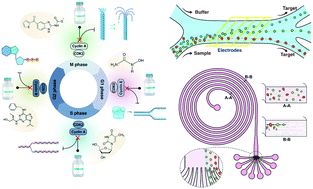Advances and enabling technologies for phase-specific cell cycle synchronisation
Abstract
Cell cycle synchronisation is the process of isolating cell populations at specific phases of the cell cycle from heterogeneous, asynchronous cell cultures. The process has important implications in targeted gene-editing and drug efficacy of cells and in studying cell cycle events and regulatory mechanisms involved in the cell cycle progression of multiple cell species. Ideally, cell cycle synchrony techniques should be applicable for all cell types, maintain synchrony across multiple cell cycle events, maintain cell viability and be robust against metabolic and physiological perturbations. In this review, we categorize cell cycle synchronisation approaches and discuss their operational principles and performance efficiencies. We highlight the advances and technological development trends from conventional methods to the more recent microfluidics-based systems. Furthermore, we discuss the opportunities and challenges for implementing high throughput cell synchronisation and provide future perspectives on synchronisation platforms, specifically hybrid cell synchrony modalities, to allow the highest level of phase-specific synchrony possible with minimal alterations in diverse types of cell cultures.



 Please wait while we load your content...
Please wait while we load your content...